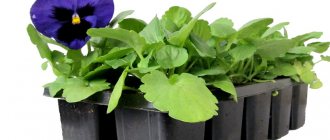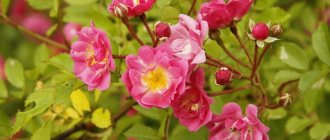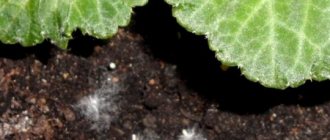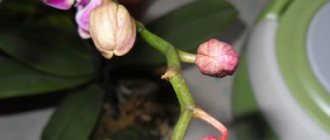There are many different types of flowers that resemble violets. They are sometimes called garden violets because they can grow outside of indoor conditions. Landscape designers often use them to decorate flower beds or garden paths. This type of plant is now very popular among gardeners. Among the flowers similar to violets are: primrose, Turkish carnation, petunia and many others, which are varied in care, but are similar to this delicate, homely flower.
Primrose
A perennial flower similar to a violet that begins to bloom immediately after the snow melts. The flowering process in good weather conditions lasts until the end of May. And although the plant resembles a violet, it is a small bush up to 30 cm in height, and the flowers are single and resemble the shape of an umbrella.
Color variety: blue, pink, lilac. Primrose also has more than 500 different species.
Reference. Primrose can be planted in any climatic conditions; it takes root well in any soil. It does not require abundant watering; it can additionally be fertilized with mineral supplements.
Everything about caring for and growing the Primrose plant at home.
Types of fertilizers and application time
Homemade primrose requires the application of a complex composition of fertilizers for feeding. These are nitrogen, potassium and phosphorus components, useful microelements. The best would be liquid fertilizers such as Agricola.
They have a balanced composition for different types of plants. They are supplied with clear instructions on how to prepare the required solution and for which colors to use it. This delicate crop does not tolerate excess salts, so the dose indicated in the instructions should be halved. Fertilizer application begins in February. At this time, buds appear. The entire flowering period continues to be applied every two weeks.
The period following flowering does not require frequent feeding. During the dormant period, the flower is not fertilized at all.
Achimenes
Indoor flowers called Achimenes can bloom 2-3 times a year. The buds bloom quickly and delight with long-lasting flowering. The plant, which resembles a violet with its flowers, is very unpretentious in maintenance, but needs sufficiently humidified air. And flowers react to temperature changes.
[adsp-pro-4]
This plant is popular because anyone can grow it at home. Achimenes dot and blueberry ripple are considered the most similar to violets. The color variety is very wide, bright colors, with a beautiful transition from light to darker shades.
Learn more about growing Achimenes at home.
Turkish clove
Gardeners love Turkish cloves for their brightness and unpretentiousness. There are low-growing plants that resemble violets, as they reach a height of 15-20 cm. And there are tall plants, more than 80 cm in height. Turkish carnation can also be planted in the garden. The big disadvantage of these flowers is that they are highly susceptible to pests.
The bright, variegated colors of the plant always attract attention.
This plant requires careful care, namely:
- weed removal;
- frequent loosening of the soil;
- frequent watering;
- fertilizer;
- protection from pests.
Pansies
Most often, this plant is grown as a biennial. They bloom in the spring, the first year. Gardeners call them violets if the plant grew in the wild. It is low-growing, and the flowers are completely similar to violets, but much larger in size.
[adsp-pro-5]
In the summer, pansies can be grown in large pots on the balcony of the house. The plant requires careful watering and bright lighting. Gardeners recommend using mineral fertilizers, which will also affect the color and brightness of flowers.
Read about how to grow pansy flowers from seeds.
Description of the plant
The flowering of pansies begins in spring and continues through the first part of summer, and in some varieties until autumn. The plant's buds appear immediately after the snow melts. The diameter of the opened flower is usually 4-10 cm. Some varieties have a subtle, pleasant aroma.
The leaves of pansies are light green in color and oval in shape. Certain varieties have serrated foliage.
The abundance of plant varieties bred is amazing. Even classifications have been invented: by the size of the flower, by the height of the bush, by the color of the petals, etc. For example, based on the diameter of flowers, they are distinguished:
- species with large flowers;
- with small ones;
- with giant ones.
Pansies in a flowerbed
Plants are divided according to height into:
- tall;
- medium height;
- undersized.
Based on the color of the petals there are:
- monochrome;
- two-color;
- varieties with contrasting spots or stripes.
Different types of pansies differ not only in external parameters, but also in the flowering period, winter hardiness and other characteristics. It is important to take this into account when choosing the right plant variety.
Gloxinia
Flowers in pots, whose name is Gloxinia, are considered very sophisticated and special. And although they have similarities with violets, the stem of gloxinia is much thicker and stronger. The flowers reach a diameter of up to 7 cm, and the plant itself requires a lot of space and light.
There are several conditions under which the plant will take root and bloom for a long time:
- Fertilizing with nitrogen-free fertilizers.
- Large pot size.
- To ensure flowering lasts all year round, you need to build an insulated rack and additional lighting.
Find out more about caring for and growing Gloxinia at home.
Petunia
And although petunia looks like a violet with its flowers, it is a large, growing bush. Its leaves are small in size, and the bush itself can be tall or short. The flowers are solitary and can come in more than 20 different colors. At the same time, they can be monochromatic or combine 2 or more colors.
Reference. Gardeners warn: to grow petunia, the soil must be neutral and loose, and sand can be used when sowing.
Read how to grow a real garden decoration - Petunia.
Growing primrose from seeds at home
The best period for propagating primrose by seeds is in April and May. It is advisable to propagate soft primrose by seeds in summer.
For planting primrose flowers, the best option would be fertile deciduous soil mixed with sand. The pot is filled with prepared soil, and seeds are sown in it. There is no need to cover the seeds with soil on top, just moisten the soil a little (make sure that mold does not appear on the soil). Glass is placed on top of the pot. Seeds require periodic aeration and spraying. The first shoots will appear in about a couple of months.
Centopoly
Centopoly or indoor violet. The fringed centopoly has gained popularity among gardeners. It is sometimes called curly. The edge of the violet is white at the right temperature. And the colors of the plant are very diverse: from light pink to dark purple. The color is also affected by the quality of the soil.
[adsp-pro-6]
You can use mineral fertilizers, which also affect the color of the plant. Centopoly needs good lighting and does not tolerate temperature changes.
Features of maintenance and care
To grow flowers in pots, you need to choose seeds suitable for home keeping. Universal soil is suitable; seeds are sown to a depth of no more than 1.5 cm.
After the seedlings emerge, you need to provide them with good lighting. Stronger plants are picked and transplanted into the main pots.
For comfortable growth and abundant flowering, plants need to be provided with:
- good lighting;
- timely watering;
- application of flower fertilizers;
- the temperature of the content is not higher than twenty degrees.
Advice! Removing faded flowers stimulates the appearance of new buds.
Deikun
The plant, called Deikun, is also called Cinderella's Dream. An unusually beautiful plant, usually with white flowers, which may be slightly tinted in a different color. At the same time, the flowers are not very large, the maximum size is 4 cm. In good conditions, the plant blooms very often and with many buds.
Gardeners warn that not everyone can grow deikun, because drafts and bright sun can affect the quality of the plant, and it may germinate without flowering.
Streptocarpus
A plant that reaches a height of 30 cm and can be grown at home in a pot. The flowers and leaves are slightly hairy and the flowers are umbrella-shaped.
The plant has many advantages:
- Easy to care for.
- Lush and long flowering (more than six months).
- If the plant does not bloom, it can be planted outside.
- Ease of reproduction.
We offer you to read a complete review of Streptocarpus indoor flowers.
Conditions of detention: table by season
In order for indoor primrose to bloom profusely and not get sick, it needs to be provided with the proper conditions depending on the time of year:
| Season | Lighting | Optimal temperature conditions | Accommodation |
| Spring, summer and autumn | Lighting should be diffused. The flower must be protected from direct sunlight | The temperature should be within +18… 20 °C | Take the flower pot out onto the veranda or balcony |
| Winter | Provide the primrose with additional lighting using a fluorescent lamp | It is advisable that the thermometer does not fall below +16 °C | Move the plant to a western or northern windowsill away from heating appliances |
Indoor primrose does not like dry air, and in such conditions its leaves begin to dry out. That is why it is recommended to constantly maintain high humidity in the room. The pot with the plant can be placed on a tray with wet expanded clay or the stems and leaves of the primrose can be sprayed periodically.
Lyubka bifolia
A plant that looks more like an orchid than a violet. The plant is not grown at home, and it does not always take root in the ground. It grows more in forest areas with high humidity, but requires good lighting.
If you grow this plant in the garden, it needs frequent watering and additional fertilizer. This plant is not very popular among gardeners due to its whimsicality and difficulty of care.
Plant care
Landing and seat selection
The appearance of pansies directly depends on the choice of planting site. In dense shade, this plant begins to degenerate: the flowers become smaller and fade, the stems become elongated, and the flowering period is shortened.
The second important factor in quality flowering is the composition of the soil. The flower develops well in fertile soil saturated with nutrients.
Planting pansies can be done in two ways:
- using seeds;
- seedlings.
When planting a flower in sunlit areas, flowering can continue until autumn. It is advisable that the plant receives sunlight for at least 5-6 hours a day.
You should not choose areas with stagnant moisture, as this threatens the development of root rot.
Sowing seeds
For better germination, it is recommended to prepare the seeds - soak them in a solution of a stimulant, for example, Epin or Zircon. They are then dried by placing them on paper.
Before adding seeds to the soil, it is loosened. They are introduced shallowly at intervals of 1 cm, after which they are carefully watered using a watering can with a fine strainer so as not to wash out the seedlings. Shoots should appear in a week and a half.
Shoots
Transplanting
To speed up the appearance of flowers, use the seedling planting method. Young plants are germinated in greenhouses or greenhouses. They begin to grow seedlings in February. Containers with sown seeds are placed in a dark place. When the shoots appear, the pots are transferred to the light.
Caring for seedlings includes timely watering and hardening. Young plants are transplanted into open ground in mid-May. Flowering can begin within a month.
Pansy seedlings
To successfully grow seedlings, it is necessary to water them on time. Do not allow the soil to become too dry or waterlogged. Watering is carried out as the soil dries. The manipulation is carried out carefully, pouring small portions of water under the root.
The soil
To successfully grow seedlings, you need to purchase a ready-made soil mixture. However, you can independently prepare nutritious soil from a mixture of peat, humus, sand and fertile soil. Before sowing seeds in the soil, it is disinfected by calcination in the oven or microwave.
When growing outdoors, the ground around the plants must be weeded and loosened, while removing dried leaves and weeds. Weeding improves air flow to the roots, which stimulates vegetation.
Top dressing
Viola needs feeding once every two weeks. Both special fertilizers for violets and universal complexes containing potassium, nitrogen and phosphorus are suitable.
On a note! If the summer is very hot, then to preserve moisture it is useful to feed the plant with organic fertilizer.
Picking
Pansies are picked when two leaves appear on the sprout. The seedling is taken out of the container with a lump of earth and the central root is carefully trimmed. This will help increase lateral root growth and rapid establishment.
Trimming
Old pansy bushes need to be pruned to stimulate the growing season. Cut off old shoots, leaving 5-6 cm in length. After this, the bush will quickly grow and throw out buds. To ensure their continued growth, it is necessary to remove faded flowers so that they do not turn into seed pods.
Pruning pansies
Wintering
Preparing a viola for winter does not include complex manipulations. With the onset of cold weather, the bushes need to be trimmed, and fertilizing and watering should be stopped. Perennial varieties of pansies tolerate winter well. To insulate them, they are covered with spruce branches, dry leaves or hay.
In the spring, the insulation is removed to prevent the plant from rotting.
Transfer
Transplantation is performed to rejuvenate the viola or to move it to a more favorable location. The bush is dug up in early spring, when active growth has not yet begun. In this case, the bed should be prepared in advance: loosen and fertilize the soil.
It is not recommended to replant the plant in the fall, otherwise it will not have time to take root in its new location and will die.
Viola garden
The plant belongs to the violet genus. Unlike pansies, garden viola reaches a height of 30 cm. It blooms very profusely and for a long time. Flowers perceive shade better than bright sun. In sandy soil the flowers can be very small. Water the plant as needed, but try not to water too much.
If diseases occur, gardeners recommend spraying the plant with a solution of calcium and soda.
With proper care, each of the plants can be grown indoors or in the garden. Plants that are similar to violets are usually not too demanding and can be grown even by amateur gardeners.
Dangerous diseases and pests
Blackleg
Pansies are unpretentious flowers that, with proper care, have good disease resistance. Possible diseases and pests:
- Gray rot. Gray spots appear on the leaves, and over time the plant is completely affected. A solution of copper oxychloride is used as prevention and control;
- Powdery mildew. Appears as a whitish coating on the leaves. Affected plants can be distinguished at the initial stage of disease development. In the place where the infection spreads, the leaves dry out and wither. For treatment, use a soap-water emulsion. The bushes are sprayed with the solution.
- Blackleg. When there is stagnation of moisture or frequent heavy watering, rot develops on the roots and stems. Infected plants are removed with a clod of earth, and the soil is disinfected. As a preventive measure, it is necessary to follow the watering regime and dosage;
- Spider mites and aphids. Dangerous pests for viola. They infect the plant, the pansies stop blooming, and over time the plant dies. When infected, the flower is treated with insecticidal preparations.











